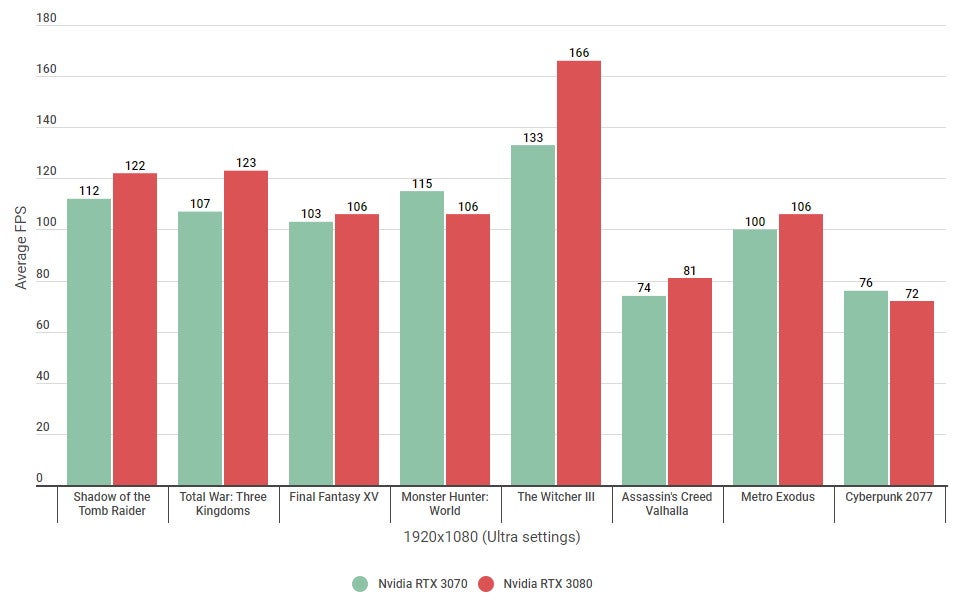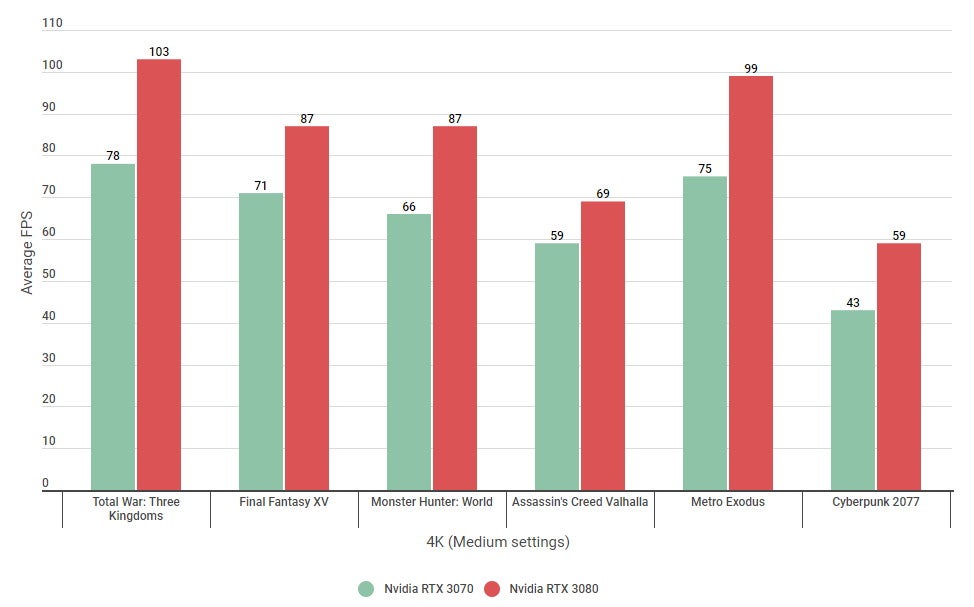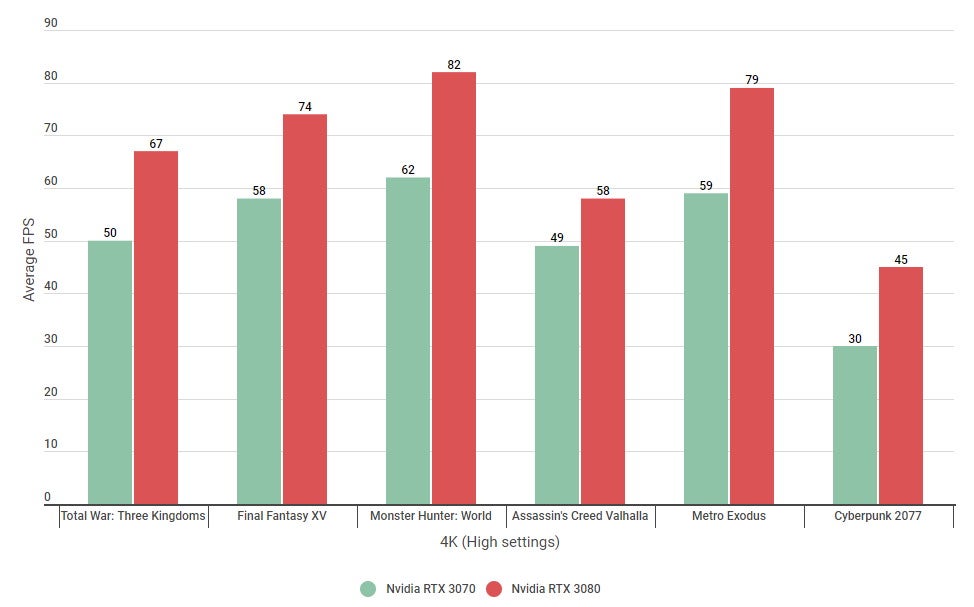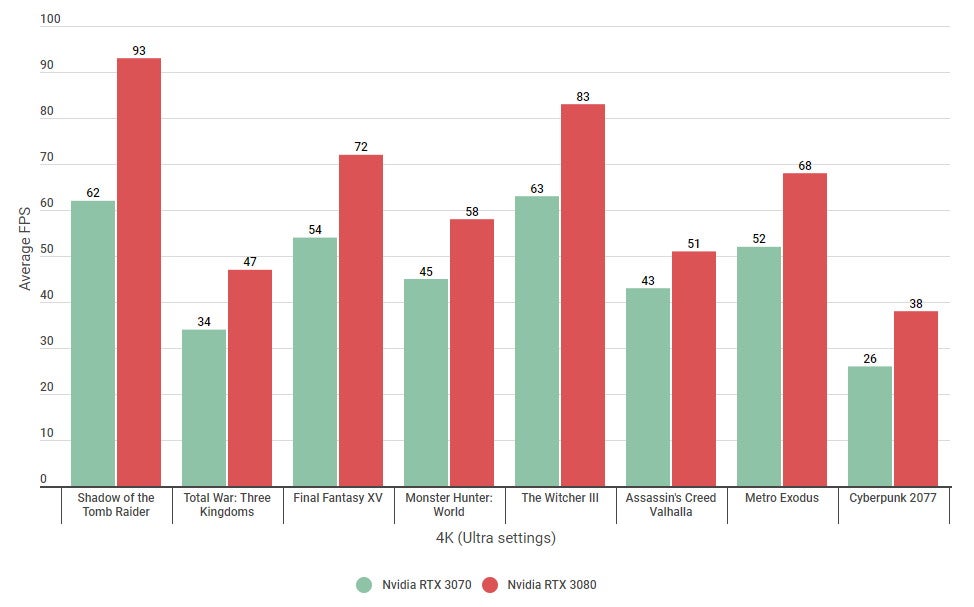Prices are, admittedly, all over the shop right now, but under normal circumstances the RTX 3080 should cost around £649 / $699. The RTX 3070, on the other hand, is £200 / $200 less, starting at £469 / $499. That’s quite a big difference if you’re budgeting for a new PC build at the moment, so you’ll want to make sure you’re getting the right graphics card for your PC before you begin. After all, if the RTX 3070 ends up being more than enough for your current needs, then there’s no need to spend another £200 / $200 on the RTX 3080. To test the RTX 3070 and RTX 3080, I used the same GPUs that I tested in my original graphics card reviews: the Zotac GeForce RTX 3070 Twin Edge and the Asus TUF Gaming GeForce RTX 3080 OC. I ran both cards at their default clock speeds, so the performance figures below should be fairly representative of what you’ll find on other types of RTX 3070 and RTX 3080 cards elsewhere. I’ve also kept ray tracing switched off for this particular comparison test, as I’ll be taking a closer look at next-gen ray tracing performance across all of the new AMD and Nvidia GPUs in a dedicated comparison piece. As for the rest of my PC specs, I paired both cards with my usual Intel Core i5-10600K processor and 16GB of Corsair Vengeance Pro RAM and put them head to head in my suite of graphics benchmarks, taking an average frame rate from their own built-in benchmarking tools or from my own repeatable manual gameplay tests. These games include a mix of blockbusters from the last couple of years: Shadow Of The Tomb Raider, Total War: Three Kingdoms, Final Fantasy XV, Monster Hunter: World, Assassin’s Creed Valhalla, The Witcher 3, Metro Exodus and Cyberpunk 2077. I tested every game at 1920x1080, 2560x1440 and 4K, so you can see exactly what’s possible across a variety of different graphics settings. Naturally, both of these cards are geared toward 4K gaming rather than playing at 1080p, and there are plenty of cheaper graphics cards available, such as the RTX 3060 Ti or AMD’s Radeon RX 5600 XT if that’s the kind of resolution you’re aiming for. I’ve included them here for the sake of completeness, but what we’re really focusing on here is how each card fares at 2560x1440 and 4K. So all that in mind, let’s take a look at some lovely bar charts.
Nvidia RTX 3070 vs 3080: 1080p benchmarks
Needless to say, neither the RTX 3070 nor RTX 3080 are going to struggle to play games at on max settings at 1920x1080 right now, as even the most demanding of today’s big games - Assassin’s Creed Valhalla and Cyberpunk 2077 - are both well into 70s and 80s when it comes to average frame rate. Admittedly, there isn’t as much of a difference as you might expect given the price difference of these two cards, and as you can see from the benchmark results below, the RTX 3070 actually had a higher average frame rate in Cyberpunk 2077 in my benchmarking results than the RTX 3080. The same thing happened in Monster Hunter: World as well, and even Final Fantasy XV was pretty much neck and neck. However, this is probably down to my choice of processor more than anything else, though, because if a graphics card is going to be CPU-bound at any of the three major resolutions these days, it’s 1920x1080. Of course, Intel’s Core i5-10600K is hardly a slouch when it comes to gaming performance, but it just goes to show that simply bunging in a new GPU to your PC doesn’t necessarily always equal faster frame rates if you don’t also have the right CPU to keep up with it. In any case, though, even if you do have a more powerful Core i7 or Ryzen 7 processor at your disposal, it’s still unlikely you’ll be able to notice a discernible difference between these two cards at 1080p - unless, of course, you’re particularly susceptible to playing games at 110fps versus 120fps. My eyes certainly can’t tell the difference between these kinds of frame rates without the aid of a frame rate counter, so there’s definitely not much point paying extra for the RTX 3080 at this resolution - especially when the even cheaper RTX 3060 Ti does it almost as well as the RTX 3070.
Nvidia RTX 3070 vs 3080: 1440p benchmarks
As I said above, though, 1080p gaming isn’t what these two cards are intended for. Instead, they’re really aimed at flawless 2560x1440 gaming and 4K. Looking at the former first, you can see below that both cards are more than capable of playing games on max settings at 1440p, as even the RTX 3070 can manage an average of 60fps+ in pretty much every game going. The only one that saw it drop below an average of 60fps was Cyberpunk 2077 - although this can be quickly remedied by enabling the game’s DLSS support. Indeed, in most cases the RTX 3080 was a good 20fps in front of the RTX 3070, although some games such as Assassin’s Creed Valhalla and Final Fantasy XV saw this gap narrow to just 7-8fps. Personally, I’d still err on the side of the RTX 3070 here, as everything can be played perfectly smoothly here (including Cyberpunk 2077 with DLSS), and I’m still not sure my eyes can really tell the difference between 70fps and 90fps - and that’s assuming you’ve got a high refresh rate monitor that can actually make use of those extra frames, too. If you’ve still got a regular 60Hz monitor, then both cards will appear to run games at a capped 60fps anyway, making the RTX 3070 the clear winner here. Of course, given that some of today’s most demanding games such as Assassin’s Creed Valhalla are already pushing the RTX 3070 pretty close to that 60fps sweet spot, some of you may think that it’s worth investing that extra cash in the RTX 3080 so you can carry on playing games on max settings at 1440p for longer. And that’s a perfectly valid conclusion, if that’s what you want to spend your money on. Alternatively, you could just knock the settings down to High and still get perfectly smooth frame rates for many more years to come. Indeed, the RTX 3070 managed an average of 72fps on High at 1440p, which isn’t really all that different from the RTX 3080’s average of 80fps on the same settings. It really depends on how much you value being able to play games on max settings all the time, and whether you’re okay with occasionally knocking the settings down to High in order to maintain those smooth 60fps performance levels.
Nvidia RTX 3070 vs 3080: 4K benchmarks
If you’re planning on buying a graphics card for 4K gaming, however, then the RTX 3080 is almost definitely worth shelling out for, particularly if you want to make sure your PC is well future-proofed against the games of tomorrow. Indeed, while both cards can hit at least 60fps on Medium settings at 4K in most of today’s big games, there are still a couple of instances where the RTX 3070 starts to show its limitations, specifically in today’s newest games, Assassin’s Creed Valhalla and Cyberpunk 2077. Of course, an average of 59fps in Valhalla is still nothing to be sniffed at, but the fact the RTX 3070 can only manage this on Medium graphics settings doesn’t bode well for its overall longevity as a 4K graphics card as the years roll on. Cyberpunk 2077 at least has the benefit of DLSS to help bump up the numbers a bit, hitting well over 60fps on Medium with DLSS switched on, but let’s not forget that the number of games that actually support DLSS right now are still few and far between. This may change over time, but right now it’s still too early to say just how prolific DLSS support is going to be down the line. Instead, the vast majority of 2021’s games and beyond are more likely to be in the same kind of situation as Assassin’s Creed Valhalla, and when we start moving up the quality scale, those near-60fps frame rates quickly start dropping pretty quickly. When we bump up the settings to High, for example, the RTX 3070 quickly starts delivering an average closer to 50fps in today’s big games, while the RTX 3080 is, for the most part, still well above 60fps, maintaining a 15-20fps lead over its RTX sibling. Again, Assassin’s Creed Valhalla remains a tough nut to crack at 4K, averaging 58fps on the RTX 3080, as does Cyberpunk 2077, where its regular, non-DLSS average levels out at just 45fps. Overall, though, the RTX 3080 is definitely in a much better position than the RTX 3070 to keep delivering those close-to-60fps / 60fps+ frame rates at these kind of quality settings as time goes on. Heck, it’s also in a better position to keep running at close-to-60fps on Ultra settings, too, as the graph below shows we’re still looking at some very decent frame rates on max settings across the board here. Indeed, while the RTX 3070 can manage 60fps in a couple of games here - Shadow Of The Tomb Raider and The Witcher III - these titles are getting on a bit now. Sure, if your Steam library largely consists of games from 2018 or earlier, then the RTX 3070 is probably going to be a pretty decent pick. However, if you’re the type of person who wants to play the latest and greatest on release, then the RTX 3080 is pretty much a no-brainer here. Naturally, there are still going to be a few games that give the RTX 3080 trouble on max settings (especially if they don’t have DLSS support) - I’m looking at you, Total War and Assassin’s Creed Valhalla - but overall that’s a pretty decent set of numbers from today’s big blockbusters. Much better than chugging along at 35-45fps like the RTX 3070 in a lot of cases, as this is the kind of difference you definitely can appreciate without the aid of a frame rate counter.
Nvidia RTX 3070 vs 3080: which is best?
Clearly, the RTX 3080 is the superior card in almost every instance when you look at the raw benchmarking figures, but unless you’ve got a 4K gaming monitor, there’s really no need to shell out all that extra cash for it. The RTX 3080 is a great card, no doubt about it, but the RTX 3070 is just as capable at delivering fast, smooth frame rates at 1920x1080 and 2560x1440, and is a much better choice for your wallet overall (and heck, if you’re really only after a card for 1920x1080, then you’d be doing yourself an even bigger favour by opting for the even cheaper RTX 3060 Ti or AMD’s Radeon RX 5600 XT instead). Indeed, the RTX 3080 really only comes into its own when you start pushing up to 4K, at which point that extra £200 / $200 starts to feels like money well spent. After all, whatever resolution you’re looking to play games at, you ideally want a card that can play games at 60fps on High settings straight off the bat, if only to make sure you’ve got enough headroom to carry on playing games at a decent quality setting at at that resolution in the years to come. If you only get a card that can do 60fps on Low or Medium settings, on the other hand, then it won’t be long before you have to abandon that resolution altogether and drop down to the next one. In summary, you should definitely save up for the RTX 3080 if you’re hankering after that high-end 4K gaming experience, but if you’ve currently only a 2560x1440 gaming monitor, then the RTX 3070 will do you just fine.
Nvidia GTX 1650 vs 1050 Ti Nvidia GTX 1650 vs 1060 Nvidia GTX 1650 vs AMD RX 570 Nvidia GTX 1660 vs 1060 Nvidia GTX 1660 vs 1660 Super Nvidia GTX 1660 vs 1660 Ti Nvidia GTX 1660 Super vs 1060 Nvidia GTX 1660 Super vs 1660 Ti Nvidia GTX 1660 Ti vs 1060 Nvidia GTX 1660 Ti vs 1070 Nvidia GTX 1660 Ti vs RTX 2060 Nvidia RTX 2060 vs GTX 1060 Nvidia RTX 2060 vs 2060 Super vs AMD RX 5700 vs RX 5700 XT Nvidia RTX 2070 vs 2070 Super vs AMD RX 5700 XT Nvidia RTX 2070 Super vs 2080 Super Nvidia RTX 2080 vs GTX 1080 Nvidia RTX 2080 Ti vs GTX 1080 Ti Nvidia RTX 3080 vs 2080 vs 2080 Super Nvidia RTX 3060 Ti vs RTX 3070 Nvidia RTX 3070 vs 3080 Nvidia RTX 3080 vs 2080 Ti AMD RX 5600 XT vs RX 5700 AMD RX 6800 vs RX 6800 XT




